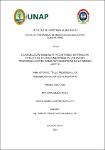Capacidad antioxidante y contenido de fenoles totales de plantas medicinales utilizadas tradicionalmente como antidiabéticas en la región Loreto

Date
2024Author
Arana Tello, Rosa Isis
Montes Macalupú, Miriam Isabel
Metadata
Show full item recordAbstract
The main objective of this study was to determine the antioxidant capacity and total phenol content of 50 medicinal plant species traditionally used as antidiabetic agents in the Loreto region. Antioxidant activity was evaluated by DPPH, ABTS and FRAP assays, and total phenol content was evaluated by Folin Ciocalteu method. The results showed that Euterpe oleracea was the species with the highest antioxidant capacity in all test. DPPH assays with a value of 5543.95 ± 178.32 µmol Trolox/g, ABTS with a value of 9775.27±5.08 µmol Trolox/g and FRAP with a value of 5725.12 ± 1.80 µmol Trolox/g. Likewise, Euterpe oleracea also presented the highest total phenol content with a value of 6376.02 ± 48.49 mg GAE/g, which evidenced a significant positive correlation between phenolic content and antioxidant capacity of the species studied. Petiveria alliacea and Urera baccifera were the species with the lowest antioxidant capacity and phenolic content. This finding highlights the importance of continuing research on the use of medicinal plants in the treatment of chronic degenerative diseases such as diabetes, since many of these species could serve as precursors of anti-diabetic nutraceutical products. The study also highlights the importance of considering factors such as the extraction method and solvent used, which influence the quantification of phenolic compounds and antioxidant activity. These results open the door to future research that can contribute to the development of pharmaceutical, food and agricultural products. Este estudio tuvo como objetivo principal determinar la capacidad antioxidante y el contenido de fenoles totales en 50 especies de plantas medicinales utilizadas tradicionalmente como antidiabéticas en la región Loreto. Se evaluó la actividad antioxidante mediante los ensayos DPPH, ABTS y FRAP, y el contenido de fenoles totales a través del método de Folin-Ciocalteu. Los resultados mostraron que Euterpe oleracea fue la especie con mayor capacidad antioxidante en todos los ensayos, DPPH con un valor de 5543.95 ± 178.32 µmol Trolox/g, ABTS con un valor de 9775.27±5.08 µmol Trolox/g, FRAP con un valor de 5725.12 ± 1.80 µmol Trolox/g. Asimismo, Euterpe oleracea presentó el mayor contenido de fenoles totales con un valor de 6376.02 ± 48.49 mg GAE/g, lo que evidenció una correlación positiva significativa entre el contenido fenólico y la capacidad antioxidante de las especies estudiadas. Petiveria alliacea y Urera baccifera fueron las especies con menor capacidad antioxidante y contenido fenólico. Este hallazgo resalta la importancia de seguir investigando el uso de plantas medicinales en el tratamiento de enfermedades crónico degenerativas como la diabetes, ya que muchas de estas especies podrían servir como precursores de productos nutracéuticos antidiabéticos. El estudio también destaca la importancia de considerar factores como el método de extracción y el solvente utilizado, que influyen en la cuantificación de los compuestos fenólicos y la actividad antioxidante. Estos resultados abren la puerta a futuras investigaciones que pueden contribuir al desarrollo de productos farmacéuticos, alimentarios y agrícolas.
Collections
- Tesis [122]

